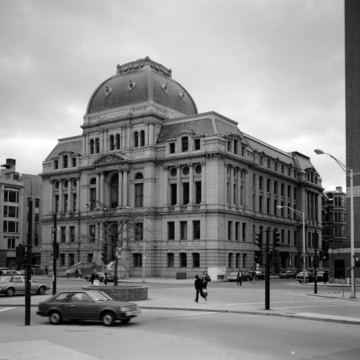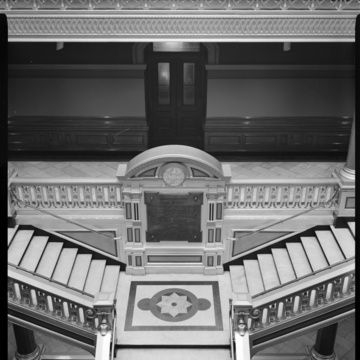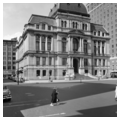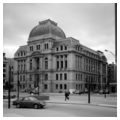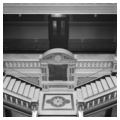Samuel J. F. Thayer's scheme in the then modish Second Empire style was the outcome of a design competition that drew twenty-one entries—including a French Renaissance–inspired design from the young firm of McKim and Mead (before White joined the team). Thayer's competition entry featured a bombastic center tower which was eliminated in costcutting efforts during a crippling economic recession following the Panic of 1873. Nevertheless, as realized, his design introduced to Providence a degree of Victorian monumental grandeur hitherto unseen locally and established a new standard for the city's public and commercial buildings. Its severe, hierarchical granite exterior contains a remarkably intact original interior, including a silver metallic central stairwell and light court with gilt and polychrome trim and fine, elaborately stenciled council and aldermen's chambers on the third floor. The building was threatened with demolition and replacement by a glass box during urban renewal planning efforts in the 1950s and 1960s, and its restoration became a favorite project of Mayor Vincent A. Cianci, Jr., even before his election in 1975. It is one of the best-preserved buildings of its period and type in the country.
You are here
Providence City Hall
1874–1878, Samuel J. F. Thayer. 1914, attic reworked, Jackson, Robertson and Adams. Late 1970s, restoration, Irving B. Haynes and Associates; wall ornamentation in council and aldermen's chambers, Robert Dodge. 25 Dorrance St.
If SAH Archipedia has been useful to you, please consider supporting it.
SAH Archipedia tells the story of the United States through its buildings, landscapes, and cities. This freely available resource empowers the public with authoritative knowledge that deepens their understanding and appreciation of the built environment. But the Society of Architectural Historians, which created SAH Archipedia with University of Virginia Press, needs your support to maintain the high-caliber research, writing, photography, cartography, editing, design, and programming that make SAH Archipedia a trusted online resource available to all who value the history of place, heritage tourism, and learning.


